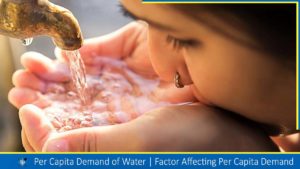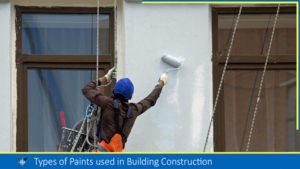Fresh green concrete can achieve its desired strength over time through continuous curing. Curing is essential for maintaining optimal moisture levels and providing a favourable environment for hydration and strength development in the concrete. By implementing proper curing practices, such as consistent moisture retention and temperature control, the concrete gradually gains strength as the chemical reactions progress. This ongoing article will further explore the importance of curing in concrete construction and delve into various methods and best practices for successful curing.
What is Concrete Curing?
Concrete curing is the process employed to retain moisture in cement concrete and maintain an appropriate temperature range. Its purpose is to ensure that the concrete remains hydrated, allowing it to develop strength. In simple terms, curing can be described as the hydration process that preserves water within the concrete while it undergoes chemical reactions and gains strength. This procedure is crucial because concrete generates significant heat during the process of initial setting of concrete into a solid mass and subsequent hardening.
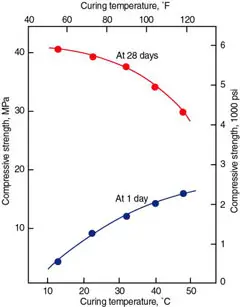
Effect of Curing
Strength development: The strength development of concrete is the primary goal which can be achieved by curing. Curing plays a crucial role in the strength development of concrete, as it directly impacts the hardening process. When concrete hardens, it generates a substantial amount of heat, which can contribute to the loss of moisture. Therefore, through proper curing techniques, the concrete can be protected and its strength development can be optimized. Curing not only increases the strength of concrete but also reduces its permeability to water (Mehta, p442).
Optimization of Temperature: Due to the hydration of cement, concrete generates a significant amount of heat, possibly up to 20 °C. Thus it is important to maintain an optimum quantity of cement content in concrete. The ideal ambient temperature during concreting is between 10 °C and 24 °C. This should be maintained throughout curing ( Chudley & Greeno, p240).
Water Retention: Due to curing on the concrete surface, enables the water retention property of concrete. Due to the hydration of cement, water can be lost through evaporation. Thus introducing surface water through curing enriches the water by retaining and preventing it from evaporating. Fresh concrete should be kept moist for at least 7 days when using OPC.
Materials for Curing
Water is most commonly used as a curing material. Sometimes water in a form of a stem is also applied for the purpose. ACI 308. 1-11 states that “Water used for curing shall be free of materials that have the potential to stain concrete or are known to cause deterioration of concrete or reinforcing steel.” The water used for mixing concrete is also suitable for the purpose. This is because the water for mixing shall be free from all inorganic and organic matter, soap, acid and alkaline. IS456: 2000 recommends water used for mixing concrete is suitable for curing.
Duration for Curing
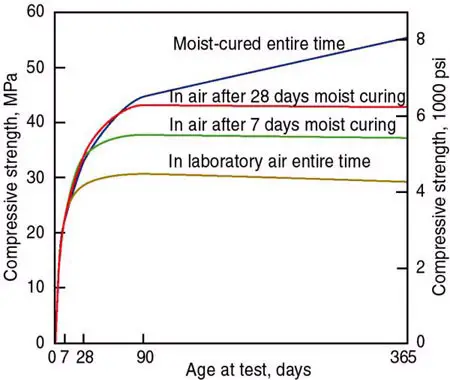
The duration depends upon the quality of cement concrete and the types and the environment in which the concrete components are cast. Slabs on the ground like floors, pavements, sidewalks, parking lots, driveways and canal linings and structural concrete members like columns, beams, slabs, bridge decks, piers, small footings, walls, and retaining walls require a minimum of seven days period for an ambient weather condition and temperatures higher than 5°C. The duration of curing depends upon the following factor: –
- Strength of the concrete
- The mixture of the concrete
- Size and shape of concrete member
- Ambient weather conditions
- Future exposure conditions
American Concrete Institute (ACI) 301 recommends a minimum curing period corresponding to concrete attaining 70 per cent of the specified compressive strength. 7 days are recommended to achieve 70 per cent of the compressive strength of concrete.
Also, as per IS 456-2000, the concrete should not be cured in less than 7 days. The minimum duration is given in the table below as per the IS 456-2000 for different materials used for preparing concrete.
| Basic | Minimum days for curing |
| OPC | 7days |
| Blended Concrete | 10days |
| Mineral admixture added | 14days |
| Hot and dry condition | 10days |
Different Methods of Curing
Different methods are adopted at the site depending upon the structural member or concrete components. These methods are as follows:-
- Water Curing
- Membrane Curing/ Compound Curing
- Steam curing
Water Curing
Water curing involves the act of applying water for a certain period of time onto the surface of freshly laid concrete after it has undergone a hardening. This method helps in maintaining the concrete’s moisture content and supporting proper hydration, promoting optimal strength development. Water curing is done following three ways:
- Ponding
- Spraying
- Wet Covering
Ponding: It is a technique commonly used on horizontally flat concrete surfaces where the creation of a water pond is possible. This method involves creating temporary water storage on the concrete surface with a height of 25 to 50 mm temporary mortar barrier. This will allow for continuous water contact and moisture retention. By utilizing ponding, the concrete receives consistent hydration and benefits from the sustained moisture environment, facilitating the desired strength development process. Ponding is usually done slabs.
Spraying: This technique is applicable to the concrete surface where ponding is not possible or practical in situations where the concrete surface is vertical or inclined. This method involves the application of a fine mist or spray of water onto the surface of the concrete. By spraying water onto the concrete surface, a thin film of moisture is created, which helps to maintain the necessary hydration levels for proper curing. The sprayed water forms a protective barrier that prevents excessive moisture loss and aids in the hydration process, allowing the concrete to develop strength and durability.
Plastered surfaces, vertical walls, columns, beams, etc. are employed with this technique of curing.
Wet Covering: This technique is applicable to both vertical and horizontal concrete members. It involves placing wet materials, such as burlap, gunny bags or fabric sheets, over the concrete to retain moisture during curing. This method helps prevent moisture loss, promotes proper hydration, and enhances strength development in the concrete.
Wet covering is particularly useful in situations where ponding or spraying is not feasible or practical. It is commonly employed in construction projects where vertical surfaces, such as walls or columns, need to be cured, as well as on horizontal surfaces like slabs or pavements.
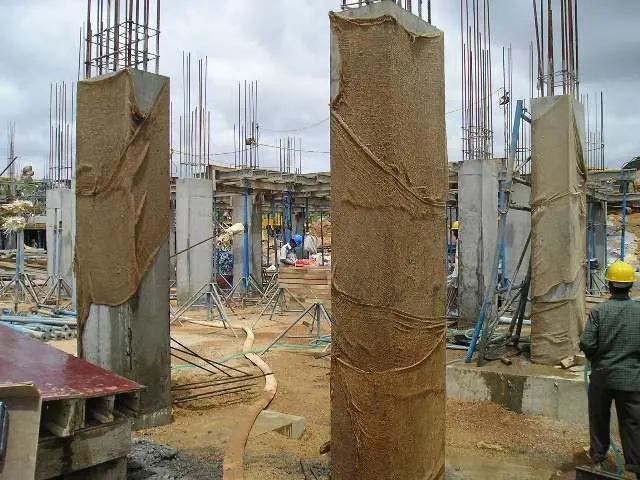
Membrane Curing/ Compound Curing
Membrane curing, also known as compound curing, is a technique used for concrete curing. It involves applying a liquid membrane-forming compound or a specialized membrane sheet onto the surface of freshly placed concrete. The primary purpose of membrane curing is to create a barrier that prevents moisture loss, allowing the concrete to properly hydrate and develop strength.
The membrane-forming compound is typically sprayed or rolled onto the concrete surface, forming a thin film. Alternatively, a pre-manufactured membrane sheet can be directly applied. This membrane acts as a protective layer, sealing the concrete surface and preventing water evaporation.
In some cases, compounds such as calcium chloride may be used in the curing process. These compounds have an affinity for moisture and help retain it on the concrete surface. This liquid membrane acts like a plastic sheet, effectively preventing moisture loss during curing. It is important to note that when subsequent surface treatments, such as floor finishes requiring concrete bonding, are planned, curing compounds should not be used. However, curing compounds are commonly used on street pavements and bridge decks where a continuous water supply is not readily available.
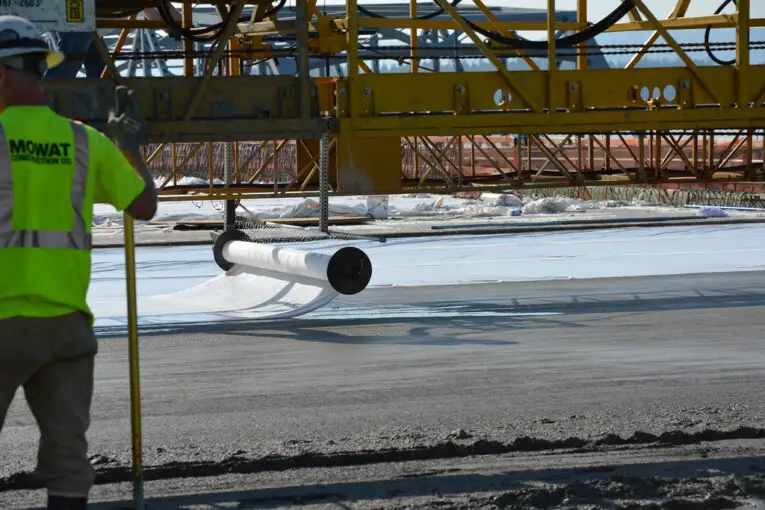
Steam Curing
In the manufacture of pre-fabricated concrete units, steam is passed over the units kept in closed chambers. It accelerates the curing process, resulting in the reduction of the curing period. There are two types of steam curing those are Low-pressure steam curing and High-pressure steam curing.
FAQs
Q: Why concrete curing is important?
Ans: Concrete curing is important as it helps prevent the loss of water from the freshly laid concrete during the hydration of the cement. During the hydration of the cement, there is a rise in the temperature generates a significant amount of heat, possibly up to 20 °C. Thus, curing helps to retain the water or moisture in the concrete so as to achieve strength and prevent possible shrinkage cracks in the future.
Q: When to start concrete curing?
Ans: Curing on construction sites commences immediately after the concrete has completely set, typically around 12 to 24 hours after placement. It is crucial to initiate curing during the early stages of hardening, and it should be sustained for an extended period, ideally lasting at least 7 days for the use of Ordinary Portland Cement.
Q: How long should concrete be cured?
Ans: According to the American Concrete Institute (ACI) 301 guidelines, it is recommended to have a minimum curing period that aligns with the concrete reaching 70 per cent of its specified compressive strength. To achieve this level of strength, a curing duration of 7 days is advised.
References:
- Greeno, R. & Chudley, R. (2014). Building Construction Handbook. Routledge. 2 Park Square, Milton Park, Abingdon, Oxon, OX14 4RN
- Mehta, M., Scarborough, W., & Armpriest, D. (2017). Building constructions: Principles, materials, and systems. Pearson Education, Inc.
- ACI SPEC-301-16 Specifications for Structural Concrete. (n.d.). https://www.concrete.org/store/productdetail.aspx?ItemID=301U16&Language=English&Units=US_Units
- Indian Standard. (2000). Plain and reinforced concrete – code of practice (IS 456:2000). Bureau of Indian Standards.
- The Constructor. (2020, July 24). What is membrane curing of concrete? – The Constructor. https://theconstructor.org/question/what-is-membrane-curing-of-concrete/
- Johnson, W. (2022, March 23). Do You Need to Keep Concrete Wet During the Curing Process? Concreteily. https://concreteily.com/concrete-wet-during-the-curing-process/
- Lead, C. (2021, November 7). What is Curing of Concrete?- Purpose, Importance, Curing Period & Methods – Civil Lead. Civil Lead. https://www.civillead.com/curing-of-concrete/
Read also:
- What is Water-Cement Ratio? | Calculation of W/C | Value of W/C
- Compressive Strength of Concrete
- Concrete Laitance | Definition | Cause | Remedy
![]()






